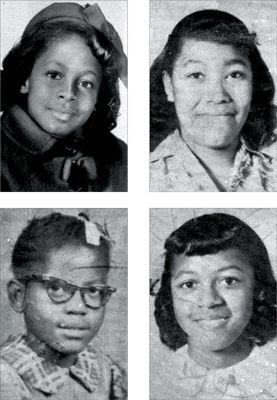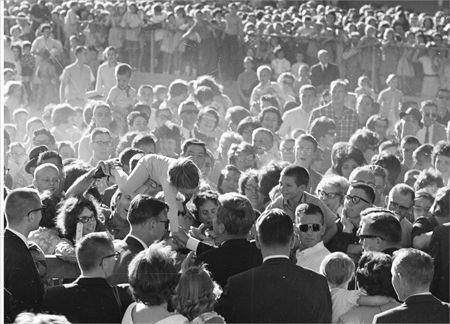Kennedy's Last Days: The Assassination That Defined a Generation (20 page)
Read Kennedy's Last Days: The Assassination That Defined a Generation Online
Authors: Bill O'Reilly

“I have a dream,” he says to King, adding a nod of the head to show approval.
CHAPTER TWENTY-THREE
SEPTEMBER 15, 1963
Birmingham, Alabama
B
UT THE
M
ARCH ON
W
ASHINGTON
does not change the ongoing racial battle in the American South. Less than three weeks after America listened to Martin Luther King Jr. dream about black boys and girls in Alabama joining hands with white boys and girls, 26 black children are led into the basement of the Sixteenth Street Baptist Church for Sunday morning services. They are due to hear a children’s sermon on “The Love That Forgives.”
The Sixteenth Street Baptist Church is the same congregation that launched the Children’s Crusade on Birmingham in May 1963. It stands just across from the park where Bull Connor’s police dogs bit into the flesh of innocent black teenagers and elementary school students. The church has earned a special level of hatred from the white supremacist groups that still battle to block the integration of Birmingham.
The children attending church this Sunday morning cannot possibly know that four members of the Ku Klux Klan have planted a box of dynamite near the basement. The force of the explosion that shatters the spiritual calm of the church service at 10:22
A.M.
is so great that it doesn’t just destroy the basement, but also blows out the back wall of the church and destroys every stained-glass window in the building but one. That lone surviving window portrays an image of Jesus; all but the face of the figure remains intact.

The victims of the Sixteenth Street Baptist Church bombing (clockwise from top left): Denise McNair, 11; Carole Robertson, 14; Cynthia Wesley, 14; and Addie Mae Collins, 14.
[© Associated Press]
The window is symbolic in a sense, because most of the children in the basement this Sunday morning survive the horrific tragedy. However, four of them—Addie Mae Collins, Cynthia Wesley, Carole Robertson, and Denise McNair—do not.
Their dream has come to an end.

This stained-glass window was partially intact after the bombing that killed four children and injured twenty-three others.
[LOC, DIG-highsm-05062]
CHAPTER TWENTY-FOUR
SEPTEMBER 25, 1963
Billings, Montana Late afternoon
E
VEN IN THE MIDST OF TRAGEDY,
Kennedy must campaign. He stands in the rodeo ring at the Yellowstone County Fairgrounds, addressing an overflowing crowd. Billings, Montana, has a population of just 53,000, and it appears as if every single citizen has come out to cheer the president. A marching band adds to the pageantry.
It seems that JFK might just win Montana if the election were held tomorrow. And success in the West is a vital part of Kennedy’s reelection strategy. A win in Texas, for example, would almost guarantee his victory in 1964.
And so Appointments Secretary Kenny O’Donnell has selected November 21 and 22 as the likely dates of Kennedy’s eagerly anticipated Texas fund-raising trip.
The president envisions a grand tour of the state, with stops in five major cities: San Antonio, Fort Worth, Dallas, Houston, and Austin. Texas governor John Connally, a conservative Democrat who has been maintaining a discreet political distance from the president, is quietly in favor of a less ambitious itinerary. Dallas, for instance, is not Kennedy territory.

JFK surrounded by Secret Service personnel deep in a crowd in Billings, Montana, in September 1963.
[JFK Presidential Library and Museum]
The president will discuss this issue, along with other details of the trip, with John Connally next week at the White House. One statistic about the Texas trip is most glaring of all: More than 62 percent of Dallas voters did not vote for John Kennedy in 1960.
But JFK loves a challenge. If Billings, Montana, can be won over, then why not Dallas—the “Big D”?

Kenny O’Donnell (right) often accompanied the president on official trips. Here he and Pierre Salinger, Kennedy’s press secretary, visit a military base in North Carolina.
[JFK Presidential Library and Museum]
CHAPTER TWENTY-FIVE
SEPTEMBER–OCTOBER 1963
Texas and Mexico City
W
HILE
P
RESIDENT
K
ENNEDY IS SPEAKING
in Montana, Lee Harvey Oswald is already on his way to Texas—and beyond. He is on a bus bound for Houston. From there, he will change buses and go south to Mexico City.
Oswald is traveling like a man who is never coming back. He has no home, because he has just abandoned his squalid New Orleans apartment. When the landlady came around demanding the $17 he owed in back rent, Oswald put her off with a lie and later sneaked out in the dead of night.
The sum of Oswald’s worldly possessions is now divided among his wallet and the two cloth suitcases stowed in the bus’s luggage bay.

The application Lee Harvey Oswald filled out in Mexico asking for a visa to go to Cuba.
[Charles Tasnadi/AP]
As for a family, Oswald no longer has one. Two days ago he sent the very pregnant Marina and 19-month-old June to live with Marina’s Quaker friend Ruth Paine, outside Dallas. George de Mohrenschildt had once again intervened to help the Oswalds. He introduced them to Ruth Paine.

Oswald distributing flyers in New Orleans.
[© Corbis]
Ruth Paine speaks a smattering of Russian, which helps to make Marina feel more at home. Marina has stored all the family possessions in Paine’s garage. Among them is a green-and-brown rolled blanket in which Lee Harvey Oswald’s rifle is concealed. Ruth Paine, being a peace-loving Quaker, would never allow the gun in her garage, but she has no idea it’s there.
Oswald has hatched a clever new scheme—one that doesn’t involve Marina. He dreams of living in the palm-tree-fringed workers’ paradise of Cuba. But it’s impossible to get a Cuban travel visa in the United States because the United States and Cuba have severed diplomatic relations. So Oswald is taking the bus to Mexico City in order to apply at the Cuban embassy there.
Lee Harvey Oswald never fits in, no matter where he goes. He is constantly searching for a place where he can belong, a place that will allow him to be the great man he so longs to be. Oswald believes that Cuba is such a place. And in his mind he has done plenty to impress the Cuban dictator, Fidel Castro. Oswald spent time in New Orleans passing out leaflets for the Fair Play for Cuba Committee, a group that wants the United States to end its economic boycott of Cuba. He feels that should prove his loyalty to communism.

The Committee flyer.
[NARA/JFK Assassination Records]